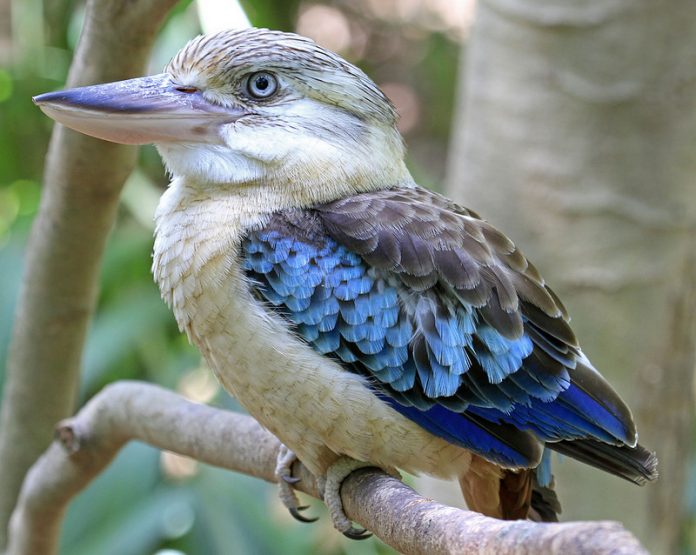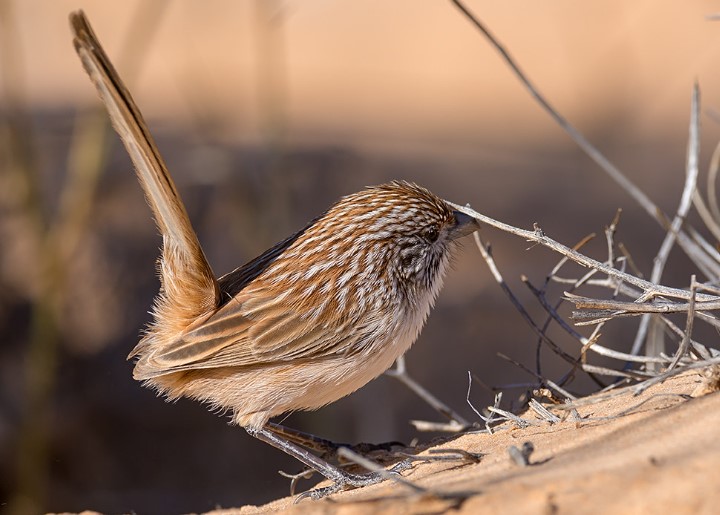The closest relative of the Laughing Kookaburra, the Blue-winged Kookaburra (Dacelo zeachii) lives in the northern and northeastern coastal fringes of Australia as well as in New Guinea. It prefers a wetter habitat than the Laughing Kookaburra and is usually found in gallery forests along creeks or in swampy coastal paperbark.
However, on the Queensland coast from Brisbane to Cape York Peninsula there are also vast areas where the two species live together. Their ranges overlap especially in places where cane fields-in which they hunt grow amid forests, and where wet woodlands give way to drier ones. There it is not unusual to see two or three Blue-winged Kookaburras and several Laughing Kookaburras perched in a row on a telephone wire, watching motionlessly for movement of prey in the cane fields below.

In a shared habitat, the two species actually interact in their territorial behavior: each bird excludes the other from its territory, almost as if it were a member of the same species. This phenomenon is fairly common between closely related species suggests that when the two kookaburras diverged as separate species while living apart in the past, differences evolved in their form rather than in their feeding and nesting requirements, which are still much the same.
The method of each species’ territorial defense against the other does not appear to be the same as when territories are defended against members of the same species. The Blue-winged Kookaburra has a less ritualistic defense displaying families circling and chasing an intruder in a loose and raucous fashion whereas the Laughing Kookaburra gives a neat performance in which the birds fly to and fro, passing each other in midair like trapeze artists, with relays of laughter reverberating between the disputing groups.
To maintain mutually exclusive land rights, the morning and evening choruses with which both species announce their territories are normally sufficient; in these, the Blue-winged Kookaburra’s high-pitched trilling howl sometimes mingles with the Laughing Kookaburra’s less frantic song. Both species have similar feeding, mating, and nesting habits, and are aided in inbreeding by auxiliary helpers.
This form of social behavior seems to have the same effect on the biology and population of each. The only difference is that the families of Blue-winged Kookaburras are often larger, up to 1 2 members. The bird is also known as Leach’s Kookaburra, Howling Jackass. The size of the Blue-winged Kookaburra is about 380-400 mm in length, including a 60-70 mm bill.
The male head is off-white, lightly to strongly streaked dirty brown. Mantle and scapulars are mid-brown; lower back and rump glistening sky-blue. Shoulders are entirely sky-blue, the tone washing down as strong mid-blue suffusion flight feathers; large white band through the base of flight feathers. The tail is mid-blue tipped white, along with throat plain is white.
Whereas, the breast of the crissum is off-white to cream-buff but variably scalloped with thin bars of the gray-brown. The eyes are cream-white, and bill with maxilla dusky and mandible cream bone. Feet are pale olive-cream to flesh-gray; claws dusky. The female is male but slightly larger, with tail feathers russet barred with blue-black. The immature is female but paler ventrally; scalloping varies with wear.
Blue-winged Kookaburra call consists of 6 or 7 short calls varying from sharp ow-ow to pronounced trill. The cacophony of rapid, high-pitched coughing cackles, is usually sung in chorus. Starts with a coarse huff-huff-huff … developing into a sharp bark of ow-ow-ow-ow and a series of trills; ends abruptly. The nesting and breeding seasons are September-January. Nest a hollow tree cavity like that of Laughing Kookaburra, but with greater preference for termite mounds and baobab trees Adansonia.
Related Reading – Ruddy Kingfisher – A Perfect Photogenic Bird







